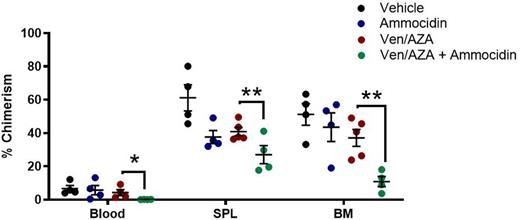Abstract
Background: BCL-2 dependent leukemia-stem cells preferentially rely on oxidative phosphorylation (OXPHOS) as a source of energy (Pei et al Cancer Discovery 2020; Stevens et al Nature Cancer 2021). BCL-2 inhibition through the use of venetoclax (VEN) has been linked to disruption of OXPHOS via reduced complex II activity. Given the use of OXPHOS by BCL-2 dependent AML cells, we sought to potentiate VEN effects by further perturbing electron transport in AML. Recently, we discovered that Ammocidin, a glycomacrolide natural product, targets leukemia OXPHOS via inhibition of ATP synthase, complex V of the electron transport chain (Reisman et al Nature Chem Bio 2022). Here, we explored the therapeutic window of simultaneous inhibition of Complex V and BCL-2 by ammocidin and VEN, respectively, in AML cells.
Methods: We treated AML cell lines MV-4-11 and MOLM-13 with ammocidin and evaluated for viability via Cell Titer-Glo. To validate the combination of ammocidin and VEN, in vivo, we transplanted the MV-4-11 cell line into immunocompromised NSGS mice. Engrafted mice were treated with either standard of care (SOC) VEN (25 mg/kg 5x/week) + azacitidine (AZA) (0.2mg/ml 3x/week), ammocidin (0.1 mg/kg 5x/week) monotherapy, or a combination of each at these doses. Total human CD45+/CD33+ cells were removed from marrow, spleen and peripheral blood of xenografted mice and measured via flow cytometry.
To further discover the efficacy of ammocidin/VEN in heterogenous AML samples, we treated primary patient AML cells with VEN, ammocidin or combination therapy. Mononuclear bone marrow cells from nine mutationally diverse patients with AML were tested and evaluated for cell viability via Cell Titer-Glo. To verify induction of apoptosis, we subjected cultured patient samples to annexin V/PI staining 24 hours after exposure to 300nM ammocidin and 100nM VEN single and combination therapy.
Results: Cell Titer-Glo assays revealed that AML cell lines MV-4-11 and MOLM-13 cells were sensitive to complex V inhibition with a GI50 of 45 and 131nM. Combining ammocidin with VEN was synergistic in both cell lines. In vivo, the addition of ammocidin to an SOC regimen revealed significant decreases of AML cells in the bone marrow (SOC vs/ SOC+ ammocidin p=0.004), blood (SOC vs/ SOC+ ammocidin p=0.04) and spleen (SOC vs/ SOC+ ammocidin p=0.006). When looking at primary AML samples, combination therapy was more effective than single-agent therapy (Ven vs VEN+ ammocidin p=0.02). Induction of apoptosis, noted through Annexin+/PI− cell staining, was significantly enhanced with the combination therapy in AML blast cells at 24 hours (VEN vs VEN+ ammocidin, p=0.007). Further studies are underway to test this combination in both VEN sensitive and resistant AML PDX primagraft models in vivo.
Conclusion: Targeting complex V and BCL-2 together resulted in the decreased expansion of human AML cell lines, and primary patient samples; and there was a preferential reduction of AML in vivo. These preliminary data represent a potential for ammocidin/VEN therapy in AML.
Disclosures
Savona:AbbVie: Consultancy, Other: travel expenses; TG Therapeutics: Consultancy, Other: Travel expenses, Research Funding; Karyopharm Therapeutics: Current equity holder in publicly-traded company, Membership on an entity's Board of Directors or advisory committees; Ryvu Therapeutics: Consultancy, Current equity holder in publicly-traded company, Membership on an entity's Board of Directors or advisory committees; ALX Oncology: Research Funding; Incyte Corporation: Research Funding; Bristol Myers Squibb: Consultancy, Membership on an entity's Board of Directors or advisory committees, Other: travel expenses; Forma: Consultancy; Astex Pharmaceuticals: Research Funding; Takeda: Consultancy; Geron: Consultancy; Taiho Pharmaceutical: Consultancy; Novartis: Consultancy; Sierra Oncology: Consultancy, Other: travel expenses.
Author notes
Asterisk with author names denotes non-ASH members.


